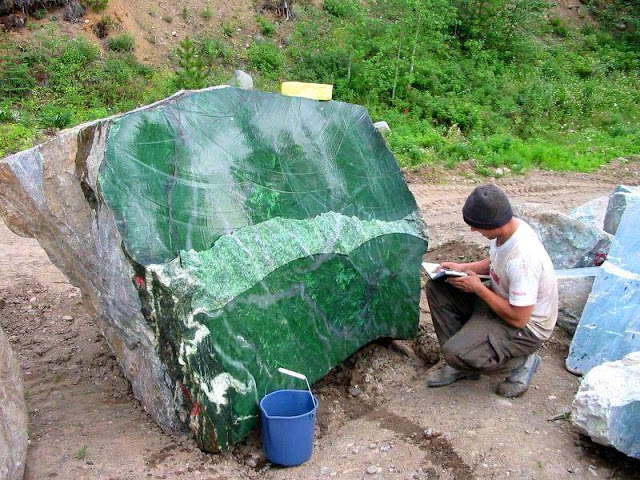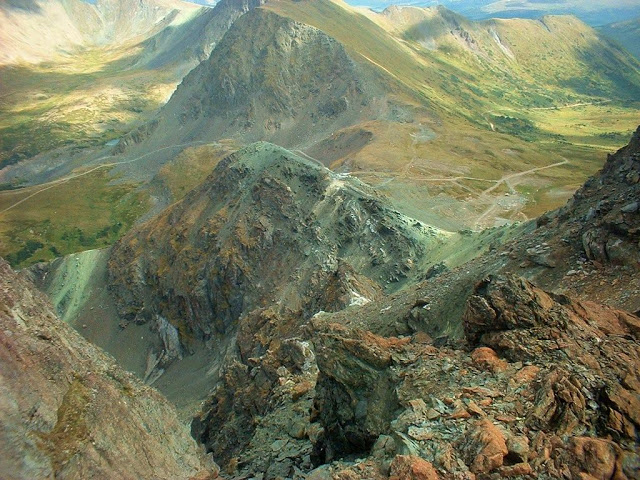It looks like you're using an Ad Blocker.
Please white-list or disable AboveTopSecret.com in your ad-blocking tool.
Thank you.
Some features of ATS will be disabled while you continue to use an ad-blocker.
12
share:
I have to admit, the story is confusing.
Jade has been mined in Canada since the 1800's
As best as I can discern from the article, the size of previous finds were smaller. Recent discoveries are massive.
I can't tell if they are saying that TONS (quantity) is what has been discovered as opposed to CHUNKS?
Anyhew, enjoy.
Geologyin.com


Jade has been mined in Canada since the 1800's
As best as I can discern from the article, the size of previous finds were smaller. Recent discoveries are massive.
I can't tell if they are saying that TONS (quantity) is what has been discovered as opposed to CHUNKS?
Anyhew, enjoy.
Geologyin.com

Nephrite deposits range from 12 inches to 12 feet wide. The wider deposits are very challenging to quarry. Nephrite boulders on the surface sometimes reach weights of 200 tons and are rarely under 100 pounds, but Jade West tries to limit the weight of its boulders to five tons, which is a reasonable size for them to mine, handle, and transport on trucks to the nearest town, about 100 miles away. The average weight is two tons, a size that satisfies most of the carving factories in China. Read more at www.geologyin.com...

edit on 13-1-2019 by LedermanStudio because: edit photos
I have about 4kg of Nephrite jade I use to make small items. One day I'll share.
The Maori people used to make weapons out of this stuff.
There are two different types of jade. nephrite as discussed in the OP, and jadeite.
The crystal structure is different as well. Both are VERY tough and useful for all kinds of things. Weapons being among their earliest use.
The Maori people used to make weapons out of this stuff.
There are two different types of jade. nephrite as discussed in the OP, and jadeite.
The crystal structure is different as well. Both are VERY tough and useful for all kinds of things. Weapons being among their earliest use.
edit on 13 1 19 by projectvxn because: (no reason given)
a reply to: LedermanStudio
Confusing ain't the half of it! I dunno jack about jade, but I do know one thing; the following paragraph from the linked article is a humdinger!!
^^^^^^^^^"Yeah...what he said!"^^^^^^^^^
Confusing ain't the half of it! I dunno jack about jade, but I do know one thing; the following paragraph from the linked article is a humdinger!!
They occur at or near the contacts of ultramafic/mafic rocks (mainly serpentinites) with cherts, and other metasedimentary or igneous felsic rocks of oceanic terranes such as the Cache Creek (Mississippian to Jurassic) and Slide Mountain (Devonian to Permian) terranes. These contacts are commonly interpreted as shear/fault related. In general, it is believed that the British Columbia nephrite formed by metasomatic exchange between ultramafic and silicabearing rocks. Impurities in the nephrite are spinel group minerals (chromite, magnetite, picolite), diopside, uvarovite, titanite, chlorite and talc.
Geologyin
^^^^^^^^^"Yeah...what he said!"^^^^^^^^^
edit on 1/13/2019 by Flyingclaydisk because: (no reason given)
edit on 1/13/2019 by Flyingclaydisk because: Double - Don't think you need to read it twice!
a reply to: Flyingclaydisk
What he said was that this nephrite was formed in a silicate matrix made up of identifiable minerals like diopside and magnetite among others.
Edit:
The inclusions you find are what identifies where the Nephrite came from.
What he said was that this nephrite was formed in a silicate matrix made up of identifiable minerals like diopside and magnetite among others.
Edit:
The inclusions you find are what identifies where the Nephrite came from.
edit on 13 1 19 by projectvxn because: (no reason given)
I know in Girdwood Alaska there used to be... (still maybe) boulders of
Jade. About half as big as the picture shows. But it was said to be common there.
Jade. About half as big as the picture shows. But it was said to be common there.
originally posted by: Flyingclaydisk
a reply to: LedermanStudio
Confusing ain't the half of it! I dunno jack about jade, but I do know one thing; the following paragraph from the linked article is a humdinger!!
They occur at or near the contacts of ultramafic/mafic rocks (mainly serpentinites) with cherts, and other metasedimentary or igneous felsic rocks of oceanic terranes such as the Cache Creek (Mississippian to Jurassic) and Slide Mountain (Devonian to Permian) terranes. These contacts are commonly interpreted as shear/fault related. In general, it is believed that the British Columbia nephrite formed by metasomatic exchange between ultramafic and silicabearing rocks. Impurities in the nephrite are spinel group minerals (chromite, magnetite, picolite), diopside, uvarovite, titanite, chlorite and talc.
Geologyin
^^^^^^^^^"Yeah...what he said!"^^^^^^^^^
It's sad.....I actually understood that pretty well. I think I need to stop doing so much research on things. I spent about a year researching rock and mineral formations and ancient mining of the great lakes area and some other major mineral fossil areas when I posted on another site called Dinosaur Home years back.
a reply to: projectvxn
I'm glad you understood it, because I sure as heck didn't.
I guess it's like any specialization, engineering or otherwise; we all have them. Heck, I might have even spoken some kinda' greek here about something I knew which looked just as foreign to someone else.
That one though was like reading a highly technical medical journal, where I just went....Huh???
It was though, after all, a technical publication so I guess it makes sense.
ETA - The only reason I commented on it really was Mom used to be heavy into Geology, and we'd always joke with her about pointing out different rock formations. If you rode behind her you'd see her pointing left and right at all this stuff. But I never heard her say any of those words before, so I was kind of like...WOW!
I'm glad you understood it, because I sure as heck didn't.
I guess it's like any specialization, engineering or otherwise; we all have them. Heck, I might have even spoken some kinda' greek here about something I knew which looked just as foreign to someone else.
That one though was like reading a highly technical medical journal, where I just went....Huh???
It was though, after all, a technical publication so I guess it makes sense.
ETA - The only reason I commented on it really was Mom used to be heavy into Geology, and we'd always joke with her about pointing out different rock formations. If you rode behind her you'd see her pointing left and right at all this stuff. But I never heard her say any of those words before, so I was kind of like...WOW!
edit on 1/13/2019 by Flyingclaydisk because: (no reason given)
new topics
-
Azerbaijan E190 Passenger Jet Shot Down by Russia
Mainstream News: 1 hours ago -
Orange County Makes Shoplifting a Felony
Other Current Events: 5 hours ago -
It's Offical Now
US Political Madness: 8 hours ago -
The reason it works is.....
General Chit Chat: 8 hours ago -
Dick Van Dyke saved from Wildfire by neighbours on his 99th birthday
People: 11 hours ago
top topics
-
Orange County Makes Shoplifting a Felony
Other Current Events: 5 hours ago, 14 flags -
It's Offical Now
US Political Madness: 8 hours ago, 11 flags -
The reason it works is.....
General Chit Chat: 8 hours ago, 7 flags -
Dick Van Dyke saved from Wildfire by neighbours on his 99th birthday
People: 11 hours ago, 6 flags -
Azerbaijan E190 Passenger Jet Shot Down by Russia
Mainstream News: 1 hours ago, 4 flags
active topics
-
Post A Funny (T&C Friendly) Pic Part IV: The LOL awakens!
General Chit Chat • 7954 • : underpass61 -
This is an interesting picture. Do we actually pick our leaders?
Politicians & People • 12 • : angelchemuel -
Azerbaijan E190 Passenger Jet Shot Down by Russia
Mainstream News • 7 • : Springbok -
Petition Calling for General Election at 564,016 and rising Fast
Political Issues • 165 • : angelchemuel -
Merry Christmas !!
General Chit Chat • 18 • : angelchemuel -
Mood Music Part VI
Music • 3764 • : Hellmutt -
Orange County Makes Shoplifting a Felony
Other Current Events • 19 • : Coelacanth55 -
It's Offical Now
US Political Madness • 10 • : rickymouse -
The Acronym Game .. Pt.4
General Chit Chat • 1027 • : FullHeathen -
NYPD arrests migrant who allegedly set woman on fire on subway train, watched her burn to death
Breaking Alternative News • 54 • : Irishhaf
12
